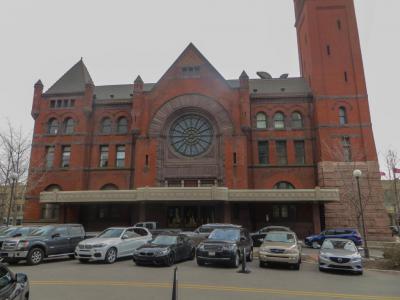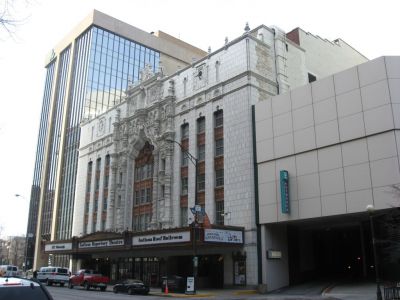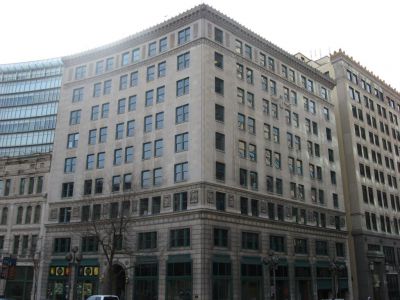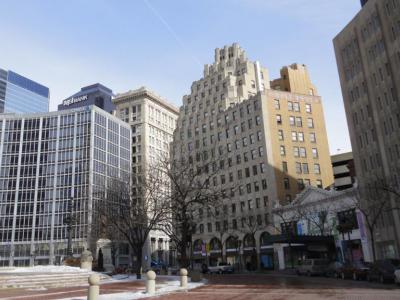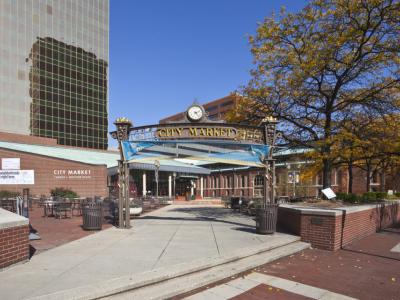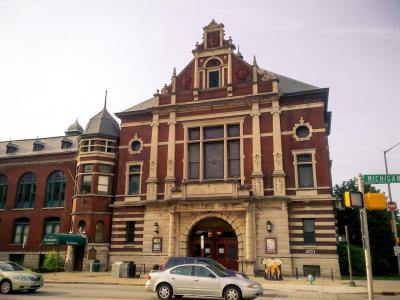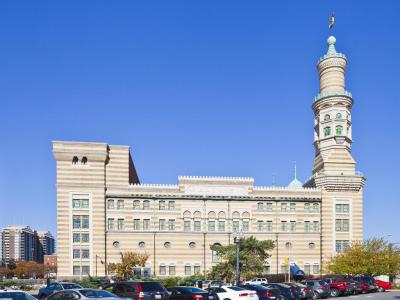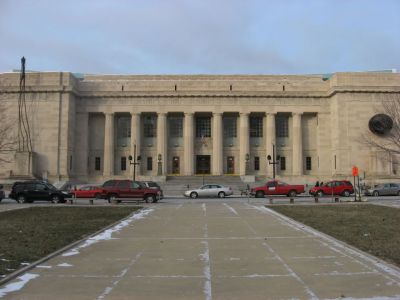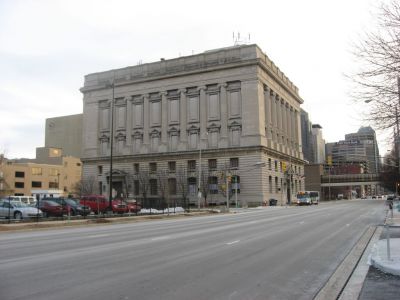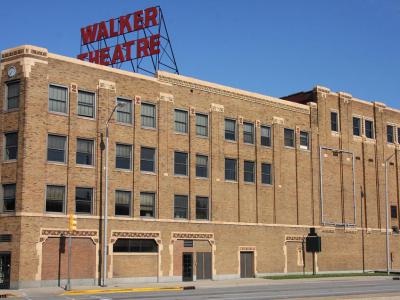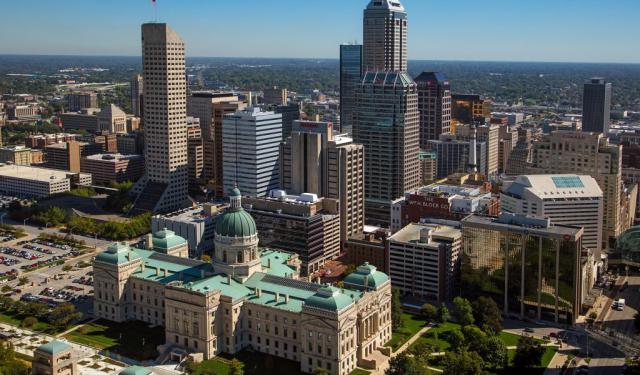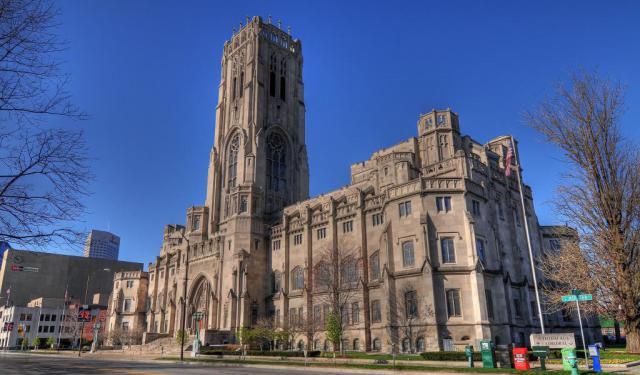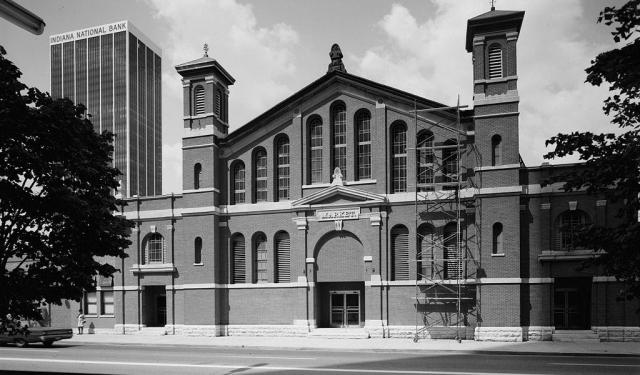
Architectural Jewels (Self Guided), Indianapolis
A number of unique constructions found throughout Indianapolis have given the city its inimitable identity. Many of them are registered on the National Register of Historic Places.
Some of the best local buildings are situated along the diagonal avenues coming from Mile Square, as per the city plan laid out in 1821 by Scottish-born architect Alexander Ralston (the one who participated in laying out a city plan for Washington DC).
Now, let's take a look at some of Indianapolis's top architectural landmarks.
Union Station, once a grand train station renowned for its imposing Richardsonian Romanesque appearance, today serves as a hotel and a bustling hub for dining and entertainment.
The Indiana Repertory Theater – a captivating venue for theatrical performances – boasts an elegant exterior, featuring elaborate plaster ornamentation based on Spanish Baroque motifs.
The Test Building, with its modernist design, stands as an element of contemporary architecture in the heart of downtown Indianapolis. Circle Tower, on the other hand, is an Art Deco piece of work that rises above Monument Circle, illustrating the city's architectural diversity.
Indianapolis City Market, housed in a charming Romanesque Revival building, is a culinary and cultural hub. The Athenaeum Building, resembling a German city hall with a basement restaurant (rathskeller), exudes a great deal of European charm.
The Old National Centre, formerly known as the Murat Shrine, is a concert venue that combines Moorish and Egyptian architectural elements. At the same time, the Indianapolis Central Library is a Greek Doric marvel, serving as a beacon of knowledge and innovation in the city.
Finally, the Indiana Freemasons' Hall is a Classical Revival beauty, while the Madame Walker Theatre showcases the grandeur of one of the few remaining African-Art Deco buildings in the United States.
Together, these architectural jewels tell the story of Indianapolis through their diverse styles and histories. Exploring them offers a unique window into the city's past and present. Whether you're a resident or a visitor looking for a dose of culture, you may want to take the time to appreciate these remarkable structures at close range. Our self-guided tour will help you with that.
Some of the best local buildings are situated along the diagonal avenues coming from Mile Square, as per the city plan laid out in 1821 by Scottish-born architect Alexander Ralston (the one who participated in laying out a city plan for Washington DC).
Now, let's take a look at some of Indianapolis's top architectural landmarks.
Union Station, once a grand train station renowned for its imposing Richardsonian Romanesque appearance, today serves as a hotel and a bustling hub for dining and entertainment.
The Indiana Repertory Theater – a captivating venue for theatrical performances – boasts an elegant exterior, featuring elaborate plaster ornamentation based on Spanish Baroque motifs.
The Test Building, with its modernist design, stands as an element of contemporary architecture in the heart of downtown Indianapolis. Circle Tower, on the other hand, is an Art Deco piece of work that rises above Monument Circle, illustrating the city's architectural diversity.
Indianapolis City Market, housed in a charming Romanesque Revival building, is a culinary and cultural hub. The Athenaeum Building, resembling a German city hall with a basement restaurant (rathskeller), exudes a great deal of European charm.
The Old National Centre, formerly known as the Murat Shrine, is a concert venue that combines Moorish and Egyptian architectural elements. At the same time, the Indianapolis Central Library is a Greek Doric marvel, serving as a beacon of knowledge and innovation in the city.
Finally, the Indiana Freemasons' Hall is a Classical Revival beauty, while the Madame Walker Theatre showcases the grandeur of one of the few remaining African-Art Deco buildings in the United States.
Together, these architectural jewels tell the story of Indianapolis through their diverse styles and histories. Exploring them offers a unique window into the city's past and present. Whether you're a resident or a visitor looking for a dose of culture, you may want to take the time to appreciate these remarkable structures at close range. Our self-guided tour will help you with that.
How it works: Download the app "GPSmyCity: Walks in 1K+ Cities" from Apple App Store or Google Play Store to your mobile phone or tablet. The app turns your mobile device into a personal tour guide and its built-in GPS navigation functions guide you from one tour stop to next. The app works offline, so no data plan is needed when traveling abroad.
Architectural Jewels Map
Guide Name: Architectural Jewels
Guide Location: USA » Indianapolis (See other walking tours in Indianapolis)
Guide Type: Self-guided Walking Tour (Sightseeing)
# of Attractions: 10
Tour Duration: 2 Hour(s)
Travel Distance: 4.6 Km or 2.9 Miles
Author: Sandra
Sight(s) Featured in This Guide:
Guide Location: USA » Indianapolis (See other walking tours in Indianapolis)
Guide Type: Self-guided Walking Tour (Sightseeing)
# of Attractions: 10
Tour Duration: 2 Hour(s)
Travel Distance: 4.6 Km or 2.9 Miles
Author: Sandra
Sight(s) Featured in This Guide:
- Union Station
- Indiana Repertory Theater
- Test Building
- Circle Tower
- Indianapolis City Market
- Athenaeum Building
- Old National Centre
- Indianapolis Central Library
- Indiana Freemasons' Hall
- Madame Walker Theatre
1) Union Station
The Indianapolis Union Station is an intercity train station in the Wholesale District of Indianapolis, Indiana. The terminal is served by Amtrak's Cardinal line, passing through Indianapolis three times weekly.
Indianapolis was the first city in the world to devise a union station, in 1848. The station building opened on September 20, 1853 at 39 Jackson Place, operated by the Indianapolis Union Railway. A much larger Richardsonian Romanesque station was designed by Pittsburgh architect Thomas Rodd and constructed at the same location beginning in November 1886 and opening in September 1888. The head house (main waiting area and office) and clock tower of this second station still stand today.
The three-story Union Station is built of granite and brick trimmed with Hummelstown brownstone,[not specific enough to verify] with a battered water table and massive brick arches characteristic of the Romanesque. It features an enormous rose window, slate roof, bartizans at section corners, and a soaring 185-foot (56 m) clock tower. The 1888 station included a large street-level iron train shed.
The station was placed on the National Register of Historic Places on July 14, 1982. Beginning in 1984, the facility was renovated and converted from its primary use as a railroad station to a festival marketplace. Union Station became a collection of restaurants, nightclubs, and specialty stores that included an NBC Store and a model train retailer. Statues of individuals who might have been seen in the railroad station in prior years were installed throughout the facility. The 273-room Crowne Plaza Hotel took up much of the western portion of the train shed, with 26 of its rooms being housed within thirteen old Pullman cars.
After 1997 the city of Indianapolis was forced to take ownership of Union Station and began to try to find another reuse for much of the building. After some time, it began leasing out space for a wide variety of purposes, including office use and an indoor go-kart track.
The 1888 station building is mostly leased for offices to pay for the building upkeep. The city struggled with finding a use for the building that is financially viable and high-profile. The Crowne Plaza Hotel still operates in the train shed structure, and leases out the main concourse, the Grand Hall, for weddings and other events.
Indianapolis was the first city in the world to devise a union station, in 1848. The station building opened on September 20, 1853 at 39 Jackson Place, operated by the Indianapolis Union Railway. A much larger Richardsonian Romanesque station was designed by Pittsburgh architect Thomas Rodd and constructed at the same location beginning in November 1886 and opening in September 1888. The head house (main waiting area and office) and clock tower of this second station still stand today.
The three-story Union Station is built of granite and brick trimmed with Hummelstown brownstone,[not specific enough to verify] with a battered water table and massive brick arches characteristic of the Romanesque. It features an enormous rose window, slate roof, bartizans at section corners, and a soaring 185-foot (56 m) clock tower. The 1888 station included a large street-level iron train shed.
The station was placed on the National Register of Historic Places on July 14, 1982. Beginning in 1984, the facility was renovated and converted from its primary use as a railroad station to a festival marketplace. Union Station became a collection of restaurants, nightclubs, and specialty stores that included an NBC Store and a model train retailer. Statues of individuals who might have been seen in the railroad station in prior years were installed throughout the facility. The 273-room Crowne Plaza Hotel took up much of the western portion of the train shed, with 26 of its rooms being housed within thirteen old Pullman cars.
After 1997 the city of Indianapolis was forced to take ownership of Union Station and began to try to find another reuse for much of the building. After some time, it began leasing out space for a wide variety of purposes, including office use and an indoor go-kart track.
The 1888 station building is mostly leased for offices to pay for the building upkeep. The city struggled with finding a use for the building that is financially viable and high-profile. The Crowne Plaza Hotel still operates in the train shed structure, and leases out the main concourse, the Grand Hall, for weddings and other events.
Sight description based on Wikipedia.
2) Indiana Repertory Theater
The Indiana Theatre was built as a movie palace and ballroom in 1927 and today is the home of the Indiana Repertory Theatre. It was added to the U.S. National Register of Historic Places in 1979. The building is six stories and is of concrete frame construction. The front of the building is sheathed in white terra cotta. The main feature of the facade is the curving triangular arch with churrigueresque framing that fills the central bay above the marquee. The original marquee is still in place. The basement originally contained bowling alleys and billiard rooms. Upper floors were divided between office space and theater space. The interior included an entrance lobby, 2.5-story main lobby and a 3,200-seat auditorium. The auditorium was distinguished by elaborate plaster ornamentation based on Spanish Baroque motifs.
The building is topped by the Indiana Roof Ballroom, a large atmospheric ballroom decorated to resemble a square surrounded by buildings with a stage at one end. The ballroom has an elliptical dome with sky effects. The theater is a major example of the American motion picture palace. The building was restored and the auditorium was extensively remodeled in 1979–80 to accommodate the needs of the Indiana Repertory Theatre.
The building is topped by the Indiana Roof Ballroom, a large atmospheric ballroom decorated to resemble a square surrounded by buildings with a stage at one end. The ballroom has an elliptical dome with sky effects. The theater is a major example of the American motion picture palace. The building was restored and the auditorium was extensively remodeled in 1979–80 to accommodate the needs of the Indiana Repertory Theatre.
Sight description based on Wikipedia.
3) Test Building
Located on Monument Circle, the Test Building is a splendid example of 1920’s architectural design. It is a nine-story, reinforced concrete structure with 12-inch thick brick and clay tile curtain walls. Its noble facade, designed in a neoclassical style, utilizes Indiana limestone. Originally a six-story construction, three more floors were added. The third level of this Indianapolis landmark is decorated with stone panels created by Alexander Sangernebo.
The mixed-use building housed the city's earliest large parking garages. It was listed on the National Register of Historic Places in 1983.
The mixed-use building housed the city's earliest large parking garages. It was listed on the National Register of Historic Places in 1983.
4) Circle Tower
Circle Tower, the tallest building on Monument Circle at 57.91 meters, was erected in 1930. An example of Art Deco architecture, with its ziggurat peak and sculptures, it is made of Indiana limestone. Its facade and entrances are decorated with Egyptian elements. Included on the National Register of Historic Places, it serves as an office building.
5) Indianapolis City Market
The Indianapolis City Market is a historic public market founded in 1821 and officially opened in its current facility in 1886. The market building is a one-story, rectangular brick building trimmed in limestone. It has a front gable center section flanked by square towers. The market was listed on the National Register of Historic Places in 1974.
Today Indianapolis City Market features over 25 local businesses that visitors will enjoy supporting. These businesses offer everything from gourmet food to boutique-style gifts and even craft beers. One of the key highlights is the Original Farmer's Market, where visitors can easily find local in-season produce, herbs and spices, and baked goods.
Some of the food merchants where you can sample different cuisine choices include Gomez BBQ, Mauricio's Pizzeria, and Ameer Middle Eastern Cuisine. Additional merchants that visitors can enjoy include Circle City Sweets, Twenty Two Juice, and The Flower Boys. Visitors will also want to stop by the Tomlinson Tap Room, with a rotating selection of 19 craft beers from Indiana.
Visitors can also take advantage of regular special events, such as live performances. Regular public art installations take place at this market, many of which coincide with holidays. Multiple merchants will also often take part in sale events for holidays.
Today Indianapolis City Market features over 25 local businesses that visitors will enjoy supporting. These businesses offer everything from gourmet food to boutique-style gifts and even craft beers. One of the key highlights is the Original Farmer's Market, where visitors can easily find local in-season produce, herbs and spices, and baked goods.
Some of the food merchants where you can sample different cuisine choices include Gomez BBQ, Mauricio's Pizzeria, and Ameer Middle Eastern Cuisine. Additional merchants that visitors can enjoy include Circle City Sweets, Twenty Two Juice, and The Flower Boys. Visitors will also want to stop by the Tomlinson Tap Room, with a rotating selection of 19 craft beers from Indiana.
Visitors can also take advantage of regular special events, such as live performances. Regular public art installations take place at this market, many of which coincide with holidays. Multiple merchants will also often take part in sale events for holidays.
6) Athenaeum Building
The Athenæum, originally named Das Deutsche Haus (German:The German House), is the most ornate and best-preserved building affiliated with the German American community of Indianapolis. Once used as a German American turnverein and clubhouse, it currently houses many groups, organizations, and businesses. It was founded in 1897 as the, the Musikverein (Music Society) and included a 60-piece orchestra, a male choir, and a mixed choir. The Athenaeum Orchestra is now the oldest orchestra in Indianapolis.
The front part of the building is the East Wing. It is built in the German Romanesque style. The entrance is flanked by two Roman Doric columns, and is arched with a semicircle of limestone. The West Wing is done in the German Renaissance Revival style and incorporates German architecture with Renaissance elements.The facade is decorated with terra cotta grotesques. One figure in particular is Athena, the building's namesake, who is placed in the top arch.
The front part of the building is the East Wing. It is built in the German Romanesque style. The entrance is flanked by two Roman Doric columns, and is arched with a semicircle of limestone. The West Wing is done in the German Renaissance Revival style and incorporates German architecture with Renaissance elements.The facade is decorated with terra cotta grotesques. One figure in particular is Athena, the building's namesake, who is placed in the top arch.
Sight description based on Wikipedia.
7) Old National Centre
The Old National Centre, founded in 1884, is owned by the Murat Shriners of the Ancient Arabic Order of the Nobles of the Mystic Shrine. The theater portion of the building (now known as the Murat Theatre at Old National Centre) houses the oldest stage house in downtown Indianapolis that is still standing today. It is the only Shrine Center in the world with a French-originating name, and it is the largest Shrine Center in North America.
In 1882, five Freemasons decided they wished to see a Shrine organization in Indianapolis. The Murat Temple was built in 1909 using the designs of Murat Shriner Oscar D. Bohlen, with Middle Eastern and Egyptian stylings that were fitting for a building intended for Shriners. Its namesake is the Nubian Desert oasis Bir Murat, which was named for the Frenchman Joachim Murat, who was one of Napoleon's generals in his Egyptian campaign.
The Murat Shrine is mostly known by the people of Indianapolis for its theater, which was built in 1910. In its early days it featured Broadway plays and even a 1932 speech by Winston Churchill. Between 1948 and 1963, it was the only road show venue in Indianapolis. Before Clowes Memorial Hall opened in 1963, it was the home of the Indianapolis Symphony Orchestra.
The Murat Shrine gave the Indianapolis Zoo its first camel and established the 500 Festival Parade.
In 1882, five Freemasons decided they wished to see a Shrine organization in Indianapolis. The Murat Temple was built in 1909 using the designs of Murat Shriner Oscar D. Bohlen, with Middle Eastern and Egyptian stylings that were fitting for a building intended for Shriners. Its namesake is the Nubian Desert oasis Bir Murat, which was named for the Frenchman Joachim Murat, who was one of Napoleon's generals in his Egyptian campaign.
The Murat Shrine is mostly known by the people of Indianapolis for its theater, which was built in 1910. In its early days it featured Broadway plays and even a 1932 speech by Winston Churchill. Between 1948 and 1963, it was the only road show venue in Indianapolis. Before Clowes Memorial Hall opened in 1963, it was the home of the Indianapolis Symphony Orchestra.
The Murat Shrine gave the Indianapolis Zoo its first camel and established the 500 Festival Parade.
Sight description based on Wikipedia.
8) Indianapolis Central Library
The Indianapolis Central Library, adjacent to the World War Memorial Plaza, was designed by Philadelphia-based architect Paul Philippe Cret. It opened to the public on October 8, 1917.
The original Central Library building was constructed in Greek Doric style architecture, faced with Indiana limestone on a Vermont marble base. The building contains a number of distinguished architectural design elements. The main reading room inside the main entrance has two flights of Maryland marble stairs and an ornamental ceiling designed by C. C. Zantzinger. The ceiling includes oil-on-canvas medallions and printers' colophons accompanied by a series of bas-relief plaster plaques depicting early-Indiana history. Reading rooms at the top of each staircase have wood paneling above oak bookcases and large leaded glass windows. Central Library was added to the National Register of Historic Places on August 28, 1975.
Central Library has undergone a number of expansions and renovations over the years. In 2001, Indianapolis-based architectural firm Woollen, Molzan and Partners was commissioned to renovate the historic building, expand with a six-story addition, and incorporate an underground parking garage. The renovated Central Library and its new atrium addition opened on December 9, 2007.
The Central Library houses the Indianapolis Special Collections Room. The collection contains a variety of archival adult and children's materials, both fiction and nonfiction books by local authors, photographs, scrapbooks, typescripts, manuscripts, autographed editions, letters, newspapers, magazines, and realia. The collection features Kurt Vonnegut, May Wright Sewall, the Woollen family, James Whitcomb Riley, and Booth Tarkington.
The original Central Library building was constructed in Greek Doric style architecture, faced with Indiana limestone on a Vermont marble base. The building contains a number of distinguished architectural design elements. The main reading room inside the main entrance has two flights of Maryland marble stairs and an ornamental ceiling designed by C. C. Zantzinger. The ceiling includes oil-on-canvas medallions and printers' colophons accompanied by a series of bas-relief plaster plaques depicting early-Indiana history. Reading rooms at the top of each staircase have wood paneling above oak bookcases and large leaded glass windows. Central Library was added to the National Register of Historic Places on August 28, 1975.
Central Library has undergone a number of expansions and renovations over the years. In 2001, Indianapolis-based architectural firm Woollen, Molzan and Partners was commissioned to renovate the historic building, expand with a six-story addition, and incorporate an underground parking garage. The renovated Central Library and its new atrium addition opened on December 9, 2007.
The Central Library houses the Indianapolis Special Collections Room. The collection contains a variety of archival adult and children's materials, both fiction and nonfiction books by local authors, photographs, scrapbooks, typescripts, manuscripts, autographed editions, letters, newspapers, magazines, and realia. The collection features Kurt Vonnegut, May Wright Sewall, the Woollen family, James Whitcomb Riley, and Booth Tarkington.
Sight description based on Wikipedia.
9) Indiana Freemasons' Hall
The current Indianapolis Masonic Temple, also known as Indiana Freemasons Hall, is a historic Masonic Temple. Construction was begun in 1908, and the building was dedicated in May 1909. It is an eight-story, Classical Revival style cubic form building faced in Indiana limestone. The building features rows of engaged Ionic order columns. It was designed by the distinguished Indianapolis architectural firm of Rubush and Hunter.
At the time of its construction the Temple held seven separate pipe organs, of which six survive and remain operable. In 1919, there were 1,174 meetings held in the Temple. More than 41,000 meals were served that year, with thirty-six banquets held in December alone.
During World War II, the south end of the basement was converted for use as a Masonic Service Club, a social and recreational area for members of the armed forces, with pool tables, a snack bar, writing desks, and a library of national newspapers–similar to a USO club.
Even the rooftop was designed for active use. Originally covered in tile, the rooftop was used for drill team practice by the Knights Templar, as well as open air parties and dinners with a view of the city. Today it is largely covered with cell phone towers and is largely inaccessible.
The Temple was listed on the National Register of Historic Places in 2008. It is also listed in the Indiana Register of Historic Sites and Structures.
The Indianapolis Masonic Temple is the statewide headquarters of the Grand Lodge F&AM of Indiana, and home to numerous individual Masonic lodges and associated groups. It is also the location of the Masonic Library and Museum of Indiana; the Indiana Masonic Home Foundation; Indiana DeMolay, and many more. The building features an auditorium, two stages, a large dining hall and catering kitchen, a ballroom, and seven large lodge rooms designed for a variety of ceremonial and social purposes.
At the time of its construction the Temple held seven separate pipe organs, of which six survive and remain operable. In 1919, there were 1,174 meetings held in the Temple. More than 41,000 meals were served that year, with thirty-six banquets held in December alone.
During World War II, the south end of the basement was converted for use as a Masonic Service Club, a social and recreational area for members of the armed forces, with pool tables, a snack bar, writing desks, and a library of national newspapers–similar to a USO club.
Even the rooftop was designed for active use. Originally covered in tile, the rooftop was used for drill team practice by the Knights Templar, as well as open air parties and dinners with a view of the city. Today it is largely covered with cell phone towers and is largely inaccessible.
The Temple was listed on the National Register of Historic Places in 2008. It is also listed in the Indiana Register of Historic Sites and Structures.
The Indianapolis Masonic Temple is the statewide headquarters of the Grand Lodge F&AM of Indiana, and home to numerous individual Masonic lodges and associated groups. It is also the location of the Masonic Library and Museum of Indiana; the Indiana Masonic Home Foundation; Indiana DeMolay, and many more. The building features an auditorium, two stages, a large dining hall and catering kitchen, a ballroom, and seven large lodge rooms designed for a variety of ceremonial and social purposes.
Sight description based on Wikipedia.
10) Madame Walker Theatre
The historic Madame C.J. Walker Building, which houses the Madame Walker Legacy Center, has long symbolized the spirit of creativity and community pride in the City of Indianapolis. Named after America’s first self-made female millionaire, Madam C.J. Walker, the site represents the achievements, art forms, culture and history of African American people. As Madame C.J. Walker Manufacturing Company, it was designated a National Historic Landmark in 1991.
Walker began the development of the Walker Building and Theatre prior to her death in 1919. The project was subsequently completed by her daughter A'Lelia Walker and opened to the public in December 1927. The four-story, multi-purpose Walker Building was designed by the Indianapolis architectural firm of Rubush & Hunter. The restored building, which includes African, Egyptian, and Moorish designs, is one of the few remaining African-Art Deco buildings in the United States. The Walker Building was added to the National Register of Historic Places in 1980.
The Walker Building, located in the heart of the Indiana Avenue Cultural District, was the center of entertainment, business and pride for the City’s African American community. Through the vibrancy of dramatic dance, the smooth, cool sounds of jazz and the evocative spirit of the theatre, the Walker Building builds bridges between artists and patrons.
Walker began the development of the Walker Building and Theatre prior to her death in 1919. The project was subsequently completed by her daughter A'Lelia Walker and opened to the public in December 1927. The four-story, multi-purpose Walker Building was designed by the Indianapolis architectural firm of Rubush & Hunter. The restored building, which includes African, Egyptian, and Moorish designs, is one of the few remaining African-Art Deco buildings in the United States. The Walker Building was added to the National Register of Historic Places in 1980.
The Walker Building, located in the heart of the Indiana Avenue Cultural District, was the center of entertainment, business and pride for the City’s African American community. Through the vibrancy of dramatic dance, the smooth, cool sounds of jazz and the evocative spirit of the theatre, the Walker Building builds bridges between artists and patrons.
Sight description based on Wikipedia.
Walking Tours in Indianapolis, Indiana
Create Your Own Walk in Indianapolis
Creating your own self-guided walk in Indianapolis is easy and fun. Choose the city attractions that you want to see and a walk route map will be created just for you. You can even set your hotel as the start point of the walk.
Indianapolis Introduction Walking Tour
The "Crossroads of America", Indianapolis (or Indy for short) is the capital of the US state of Indiana and the heart of the American Midwest.
The Indigenous people had lived in this area since as early as 10,000 BC before they relinquished their tribal land to the United States, in the Treaty of Saint Mary's, in 1818. The Eiteljorg Museum of American Indians and Western Art in... view more
Tour Duration: 2 Hour(s)
Travel Distance: 4.5 Km or 2.8 Miles
The Indigenous people had lived in this area since as early as 10,000 BC before they relinquished their tribal land to the United States, in the Treaty of Saint Mary's, in 1818. The Eiteljorg Museum of American Indians and Western Art in... view more
Tour Duration: 2 Hour(s)
Travel Distance: 4.5 Km or 2.8 Miles
Historical Churches Walking Tour
The rich history of Indianapolis is reflected, among other things, in the extensive collection of historical churches. Throughout decades, these sacred landmarks have influenced the social geography of the city and today serve as symbols of the city's cultural and architectural heritage.
One such is the Scottish Rite Cathedral, a prominent example of Neo-Gothic style, known for its... view more
Tour Duration: 1 Hour(s)
Travel Distance: 2.8 Km or 1.7 Miles
One such is the Scottish Rite Cathedral, a prominent example of Neo-Gothic style, known for its... view more
Tour Duration: 1 Hour(s)
Travel Distance: 2.8 Km or 1.7 Miles
The Most Popular Cities
/ view all
